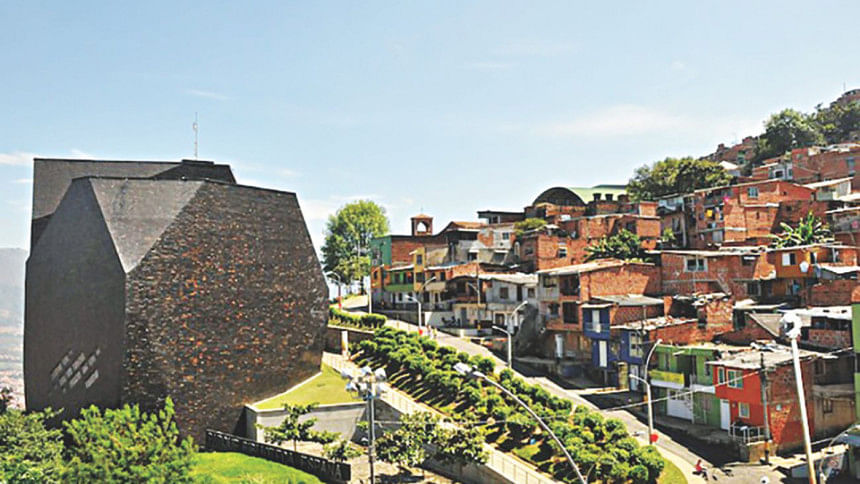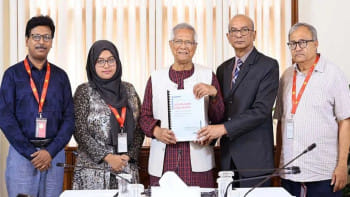The perils of a city divided: What Medellín's transformation can teach us about fixing Dhaka

"We want to get into power—why? What are the problems we are going to solve? What we want to attack is inequality, violence and corruption."
That is how Sergio Fajardo, a Colombian mathematician-turned-politician who was elected mayor of the city of Medellín in 2003, outlines how the commitment of a group of concerned citizens and politicians managed to turn the once drug-and-murder capital of the world to what it is today—a globally celebrated example of the role that architecture, combined with a citizenry and politicians dedicated towards a new future, can play to create a more liveable city. The quote is from Justin McGuirk's book Radical Cities: Across Latin America in Search of a New Architecture. In the chapter dedicated to Medellín, McGuirk writes:
"When he [Fajardo] mentions building schools and libraries, he points his pen at the inequality box. When he refers to new public spaces, he lingers over the violence box. It was this disciplined focus on social goals that he feels gave the urban renewal projects of Medellín their political power. But in order to implement this vision, he had to overcome target number three: corruption."
All three issues that Fajardo set out to tackle are all too familiar to us in Dhaka—the social divide between the slums and the high-rises, the fear and insecurity of the streets, and the corruption and lack of coordination when it comes to planning the city, home to around 18 million and rising. With wave upon wave of internal migration to Dhaka, the growing disproportion between the population growth and what the city's roads and housing facilities can accommodate, the rapidly disappearing parks and other public spaces, the reign of complete chaos on the streets, is there anything we can learn from Medellín?
What Fajardo identified in the above quote about inequality is very significant. It seems almost like common sense that when a community is so cut off from general amenities and their scope for education and livelihood is severely restricted, it will be plagued by youth unemployment, and subsequently crime. Take the case of the Geneva camp in Mohammadpur, where, last May, a thousand law enforcement personnel descended and rounded up over 150 people suspected to be drug dealers. Who would have thought that drugs and the drug trade would be problems in the camps and slums—where entire marginalised communities live in squalid conditions year after year, without proper electricity and water supplies, where access to education is still a problem? And how exactly does cracking down on them with the full force of the law help solve any of the underlying issues if we are not bridging the divides that separate the slums from the adjacent high-rises?
As César Gaviria, the former president of Colombia who was personally involved in taking down notorious drug trafficker Pablo Escobar in 1993, wrote in a New York Times article in 2017: "My government and every administration since threw everything at the problem—from fumigating crops to jailing every drug pusher in sight. Not only did we fail to eradicate drug production, trafficking and consumption in Colombia, but we also pushed drugs and crime into neighboring countries... We do not believe that military hardware, repressive policing and bigger prisons are the answer. Real reductions in drug supply and demand will come through improving public health and safety, strengthening anticorruption measures... and investing in sustainable development."
That is where the story of Medellín can shed some light, at least regarding how architecture and urban planning can be means to tackle social issues. In the 1990s, the city was known worldwide as the murder capital of the world—between 1990 and 1993, more than 6,000 people were being killed in Medellín every year. Indeed there were basically two Medellíns: "the gridded city in the valley and the informal settlements on the hills," as The Guardian's Story of Cities series points out. Half of Medellín's population lives in informal settlements—slums, or comunas in the hills surrounding the city.
Today, the city's murder rate has dropped by 80-90 percent. A string of public initiatives helmed by three consecutive mayors dedicated to make a change has brought it some astounding transformations. As a mayoral candidate, Fajardo went around the city, personally talking to those he would represent, understanding their problems, and, most importantly, making them part of the process. His predecessor, Luis Perez, had already started projects to bridge the urban divide, the most astounding of which is probably the cable car—straight out of fancy ski resorts—connecting the slums to the city, a big investment for the most poor who had to spend hours to get to work before. This proved to be life-changing for those living in the slums, and surveys show that they would rather "give up their mobile phones than the cable car."
Fajardo's tenure built on those achievements, creating more urban spaces to generate a sense of citizenry among the people. A significant portion of the budget was dedicated to the poorest districts—thus the poorer neighbourhoods were given the fanciest schools. Libraries were built precisely in locations where access to education was a problem. The concept of library-parks was introduced as spaces where the youth could play sports and have access to resources—where education meets public spaces, where a segregated society can come together. If people had to be displaced for building something, their rehousing was made a priority. Whereas urban planning everywhere tries to pretend and hide the fact that slums exist, Medellín embraced them and invested in them.
The success of Medellín owes a lot to making those who never had a voice a part of the process. When libraries were built in the comunas, it was not a patronising expression by the authorities, but a symbol of the fact that everyone had a right to access education. It was not a top-down handout but a reflection of the needs of people living on the margins. The plan to tackle urban inequality with heavy investment on education strikes out particularly. The school dropout rate has gone down from 50 percent in 2004 to 20 percent around 2015, and this has meant that children in Medellín hope today to be doctors, economists and engineers. That in itself is a massive success.
Of course, Dhaka is home to a far greater population than Medellín, and urban planning solutions cannot be the only solution. Decentralisation, so that people have opportunities elsewhere and the concentration of lives in this small space can be reduced, is necessary. But as our spending on public infrastructure increases, we are focussing more on quantity rather than thinking about if the infrastructure can actually solve our issues. Where are our public housing projects for the 35 percent population of Dhaka who live in informal settlements? We are quick to identify—and as the recent war on drugs shows, crack down on—slums as places which breed violence and the drug trade. Where are policies to bridge that divide, and provide children growing up in these slums with alternatives and hope?
Urban planning as a goal in itself can only result in more spending on infrastructure, political point-scoring about the number of projects undertaken, unfulfilled promises, and fattening the wallets of construction companies. Political commitment to solve urban issues, the key factor, is certainly missing here. What Medellín can teach us is that our problems are not beyond solutions. What we need is an informed citizenry committed to the change we want, political willingness to tackle the underlying issues of inequality, violence and corruption, and professionals who have the creative drive and social commitment to design the solutions.
Moyukh Mahtab is a member of the editorial team at The Daily Star.





Comments